ISSN ONLINE(2319-8753)PRINT(2347-6710)
ISSN ONLINE(2319-8753)PRINT(2347-6710)
P.C.Aruna Kumara1, P.Dinesh2
|
| Related article at Pubmed, Scholar Google |
Visit for more related articles at International Journal of Innovative Research in Science, Engineering and Technology
Study of crack growth and its propagation under fatigue load is important as the crack growth can end up in premature failure of components. Such failures have to be avoided especially in power plants and aerospace applications since the components in these applications are subjected to extreme temperatures. In the present work, studies have been carried on the fatigue crack growth of aluminium 2024 alloy. The test specimens were annealed and cryotreated and subjected to fatigue crack growth (FCG) tests as per ASTM E-647 standards. The fatigue crack growth behaviour has been analysed and explained based on the microstructure. The FCG test results of the heat treated and untreated specimens clearly indicate significant improvement of the fatigue life and fracture toughness of cryotreated specimens
Keywords |
| Fatigue crack growth, Annealing, ASTM E-647, Cryogenic treatment. |
INTRODUCTION |
| Fatigue and impact loads are considered very seriously in the design of components especially in aircrafts, ships, and thermal power plants. The study of crack growth and propagation is very important in such components subjected to fatigue and impact loads. Aluminium alloys are of great importance when relatively high strength, good corrosion resistance and high toughness are required in conjunction with good formability and weld ability. Aluminium alloy, Al 2024-T351 with Cu and Zn as alloying elements has many applications on aircraft fittings, gears and shafts, hydraulic valves, nuts, pistons, worm gears, couplings and fastening devices .The fatigue crack growth study involves the prediction of the fatigue life, fracture toughness, crack growth rate and stress intensity range of a structure or machine component subjected to a given stress–time history. Due to the increasing use of Al 2024 alloy components in automotive and aerospace applications that involve cyclic loading, fatigue and fatigue crack growth characteristics of Al 2024 are of great interest. In the present investigation Al 2024 is selected for the study of crack growth and propagation under fatigue loading. Compact test (CT) specimens were prepared as per ASTM E-647 standards for fatigue crack growth tests. Specimens were subjected to processes of annealing, cryotreatment and a combination of annealing and cryo treatment. The results obtained from the tests were analysed with the help of microstructures. |
II.RELATED WORK |
| Examination of the mechanism of fatigue-crack propagation with particular emphasis on the similarities and differences between cyclic crack growth in ductile materials such as metals, and corresponding behaviour in brittle materials was examined by R.O. Ritchie [5].This was achieved by considering the process of fatigue crack growth as a mutual competition between intrinsic mechanisms of crack advance ahead of the crack tip, which promote crack growth, and extrinsic mechanisms of crack – tip shielding behind the tip, which impede it. Influence of heat treatment on fatigue crack growth in heat treated Al-8089 alloy was studied [16].From the experimental data it was observed that heat treated alloy possessed acceptable level of crack resistance ,compared to other high strength aluminium alloys. |
III. MATERIAL SELECTION |
| Al 2024 was selected for the study as this material finds applications in aircraft and automobile industries. The chemical composition of Al 2024 alloy is shown in table I. |
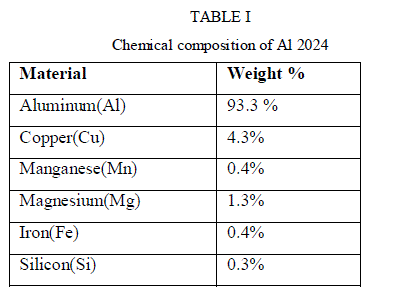 |
IV.EXPERIMENTAL DETAILS |
| A. Specimen Preparation |
| Fatigue crack growth tests characterize the rate at which pre-existing cracks in metals, ceramics, composites and other materials propagate as a function of a cyclic driving force, most commonly the range of applied stress intensity. Fatigue crack growth tests generate data that can be used as a basis for setting inspection intervals in components designed for damage tolerance. Specimens as per ASTM E-647[10] were prepared with 12.5 mm thickness as shown in fig.1. |
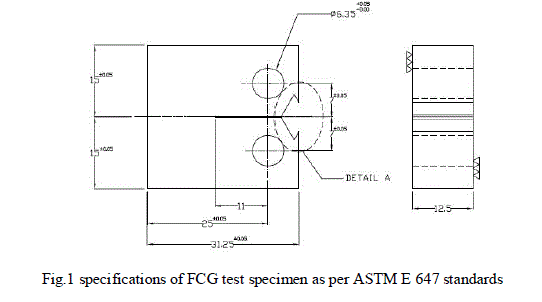 |
| B.Heat treatment of specimens The specimens of FCG tests were subjected to annealing, cryogenic treatment and the combination of heat treatment followed by cryogenic treatment. Annealing was carried out at 4500 C for one hour followed by cooling in the furnace for 24 hours. Cryogenic treatment was carried at -1780 C for 24 hours with 4 hours of cool down and 9 hours of warming up time in a specially developed cryotreatment unit using liquid nitrogen as the coolant.The setup used is as shown in Fig.2 |
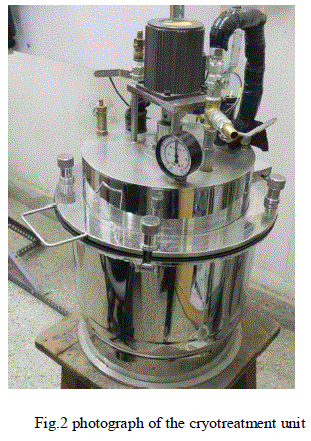 |
| C. Fatigue crack growth Test Fatigue crack growth tests were carried out using servo hydraulic controlled fatigue crack growth testing machine of 25 KN capacity as per ASTM E-647 standards. FCG tests were carried out at a loading frequency of 30 Hz, Load ratio of 0.1 for maximum load of 2 KN, minimum load of 0.2 KN with Constant amplitude cycle. Fig. 3 shows the FCG test setup. |
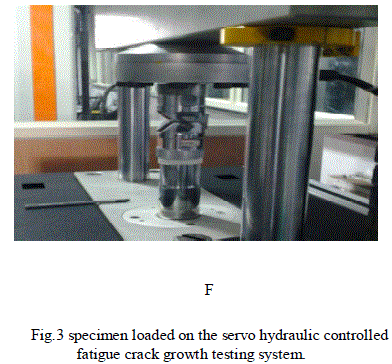 |
| D. Microstructure of Al-2024 alloy Microstructure and material flow have a significant influence on the mechanical properties and surface quality [9]. Microstructure analysis includes measurement of grain size, determination of inclusions, phase determination and density of dislocations. In the present investigation microstructure of Al 2024 alloy was obtained using inverted metallurgical microscope for different heat treatment conditions at 200X and 500X magnifications. |
V. RESULTS AND DISCUSSIONS |
| The test results of FCG and microstructure analysis are discussed as follows. A.Test results and microstructure for Untreated Al 2024 |
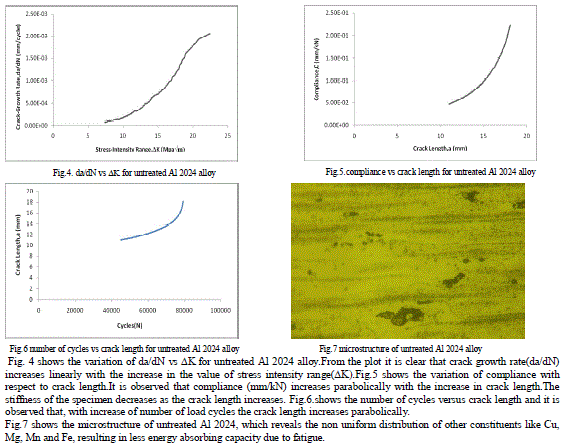 |
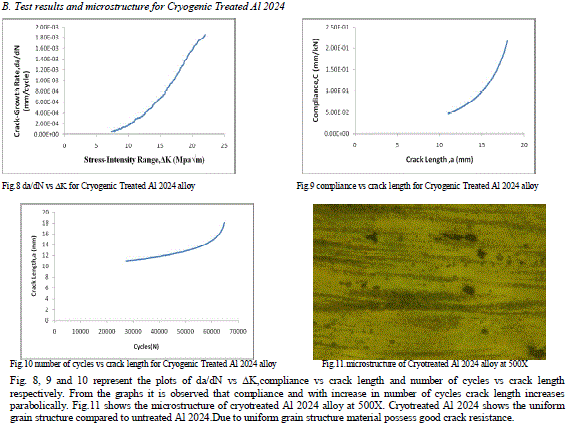 |
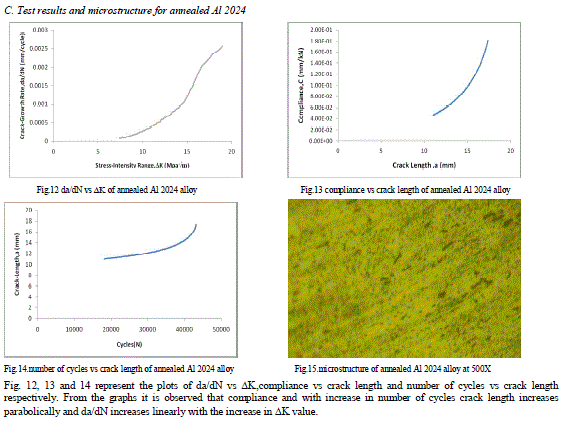 |
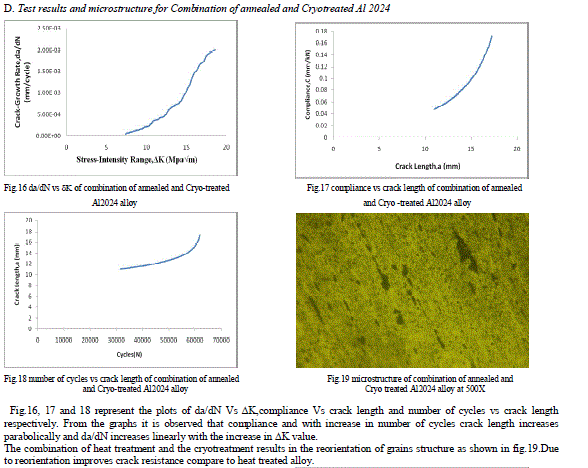 |
 |
| Fig.20 shows a comparison of number of cycles to failure of the specimen under different heat treated conditions. From the plot it is clear that number of cycles to failure under FCG is maximum for cryotreated Al 2024 specimen, due to uniform grain structure formed resulting in improved crack resistance. The annealed specimen shows least crack resistance due to the increase in brittleness. It is also observed that there is improvement in crack resistance for an alloy subjected to a combination of annealing and cryo-treatment,mainly due to re orientation of grain structure. Table II shows the maximum and minimum compliance for Al 2024 under different heat treated conditions. Annealed samples possessed less compliance due to increase in brittleness, where as cryotreated specimen showed higher value of compliance as uniform grain structure was formed. This shows that annealed sample possesses high stiffness compared to cryotreated and untreated samples. Fig.21 shows the variation of fracture toughness for different heat treated Al 2024 alloys. From the graph it is noticed that cryotreated alloy possessed higher value of fracture toughness compared with the heat treated alloy. It is due to the capacity of the specimen to absorb more energy due to the formation of uniform grain structure. |
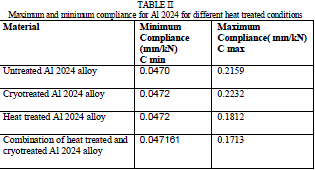 |
VI. CONCLUSION |
| The fatigue crack growth (FCG) specimens of Al 2024 were prepared as per ASTM E-647 standards and were annealed, cryotreated and subjected to a combination of annealing and cryotreatment.The samples were tested for FCG at constant amplitude cycle with load ratio 0.1 and frequency 30 Hz. From the experimental results it was found that compliance of the material increases parabolically as the crack length increases in all the specimens of Al 2024 alloy. Crack growth rate per cycle (da/dN) increases linearly with respect to stress intensity range. As the number of fatigue cycles increases crack length also increases parabolically.Microstructure of cryotreated specimen indicates the formation of uniform grain structure resulting in the improved crack resistance. |
References |
|